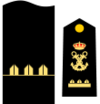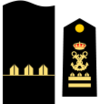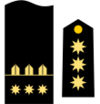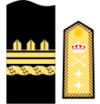Imperial Navy of Temuair Marine Infantry: Difference between revisions
No edit summary |
|||
| Line 194: | Line 194: | ||
! style="background: lavender;" colspan="5" | Handguns | ! style="background: lavender;" colspan="5" | Handguns | ||
|- | |- | ||
| [[P-11]] | | [[P-11]] || <center> {{Flag|Temuair}} || <center> Combat pistol </center> || [[9x19 mm B1997]] || | ||
| | |||
|- | |- | ||
! style="background: lavender;" colspan="5" | Submachine guns | ! style="background: lavender;" colspan="5" | Submachine guns | ||
Revision as of 05:22, 12 May 2019
This article is incomplete because it is pending further input from participants, or it is a work-in-progress by one author. Please comment on this article's talk page to share your input, comments and questions. Note: To contribute to this article, you may need to seek help from the author(s) of this page. |
| Imperial Navy of Temuair Marine Infantry | |
|---|---|
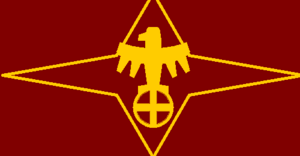 | |
| Active | 1537 - Present |
| Country | |
| Type | Naval Infantry |
| Mascot(s) | Cabaleiro Ceannlaidir |
| Commanders | |
| Emperador | Vitor Avila |
| Defense Minister | Rodrigo Lua |
| Knight-Commander | Nicolau Millian |
| Coronel Xeneral | Marcial Belasco |
The Imperial Navy of Temuair Marine Infantry, often referred to as the Imperial Navy Marine Infantry or ismply Imperial Marines is a heavy corps sized naval infantry formation integrated into the Imperial Navy of Temuair and is responsible for conducting amphibious warfare operations by utilizing naval platforms and resources to project an amphibious force onto a hostile, or potentially hostile, coast or shore. The Imperial Marinesare not only a fleet force, but are responsible for the defense and security forces of naval bases and facilities, naval schools and training units, and all facilities that support the Imperial Marines themselves.
The Imperial Marines were created in 1523 by King Marcelin V of Temuair, making them one of the oldest marine infantry formations in the world. Due to this, the brigades of the Imperial Marines trace their linage back further than many units of the Imperial Army of Temuair and have the right to be considered "Imperial" formations, an honor usually reserved for the original twenty-five tercios of King Marcelin V's Army of Conquest.
Imperial Marine Brigades are usually forward deployed through out the Temuair Empire and act as regional quick reaction forces. The Imperial Navy will station the vessel and equipment necessary to transport and equip Imperial Marines, as well as sufficient escort vessels, in nearby locations to allow for rapid deployed. Currently the Imperial Marines are the largest standing force operating with the Imperial Armed Forces.
History
The Imperial Marines were created in 1523 by King Marcelin V of Temuair. Marcelin V desired a pure naval power projection force which could set ashore forces deployed from ships who would maintain their ability to fight despite being based on board. Following the method of origination developed for the Royal Army of Temuair in 1490, the initial Imperial Marine units were organized as tercios and were organized as their Royal Army counterparts; one third musketeers, one third spear-men and the final third of pike-men. As with the Royal Army of Temuair, and later the Imperial Army, these formations were reorganized into regiments, and later brigades. As with many older formations within the Imperial Army, the Imperial Marines trace their lineage directly back to original tercios and therefore have the right to be known first as "royal" formations and later, Imperial formations.
As the Aisling Empire expanded through the 16th, 17th nd 18th century, the practice of stationing Imperial Marine troops abroad was common with every major Imperial outpost having at least a company of Marines present.
In 1920, the Imperial Navy of Temuair Marine Infantry were allowed to established an independent basic training program which focused on developing a recruits physical fitness and combat skills. Prior to this, Imperial Marines completed basic training with Imperial Navy personnel and Marine training was done as Advanced Individual Training. At this same time, the Imperial Marines published a new rank structure more closely aligned with that of the Imperial Army of Temuair, with some notable difference.
In 1951, the Imperial Navy decided to recall the various Imperial Marine formations dispersed throughout the Empire and reconsolidate them into full brigade sized forces again. These forces were again dispersed through out the Empire's overseas holdings but reequipped and deployed to act as reactionary forces within the region. The First Imperial Marine Brigade Marine brigade was sent to Afastado in southern Ashizwe and responsible for the protection of Esperamos Illa. A company of Imperial Marines was placed on the island in 1955, and was rotated out every year with another from the First Imperial Marine Brigade. This practice continued after the Gliocan Lunatic Asylum was closed in 1970, but was stopped in 1990 when the entire island was sold to the ParaCell (Pardes)|ParaCell Corporation]]. In addition, the First Imperial Marine Brigade was charged with responding to any incident within southern Ashizwe. The Second Imperial Marine Brigade was deployed to Terrica in 1954 and has remained there since. It is tasked with the defense of the Terrican Islands as well as acting as a rapid reaction force for northern Ashizwe. Modernly it has been involved in the various Terrican Emergencies and is currently deployed in support of Operation Implicit Resolve. The Third Imperial Marine Brigade consist of forces recalled from both Leónidade and Pequeñoya. It was reconsistued in Leónidade and has remained there since its redeployment in 1956. This effectively left Pequeñoya defenseless minus its Imperial Territorial Defense Force formation. The 2/3 Imperial Marine Battalion previously stationed in Pequeñoya was replaced by the 79th Tiradores Battalion. This draw down is often believed to have been one of the ley factors in allowing the success of the 1957 Pequeñoya Secession.
Battles and interventions
Organization
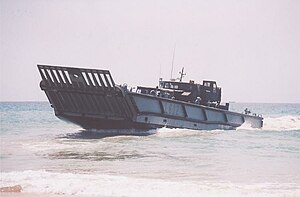
First Imperial Marine Brigade
The First Imperial Marine Brigade consists of three battalions each comprised of one infantry company and two mechanized infantry companies along with a single armored battalion, a special weapons company, and field artillery battery for each battalion. The brigade also includes supporting units such as additional artillery batteries, rocket artillery, as well as reconnaissance, engineering, signals and intelligence units. Mechanized Imperial Marine battalions are currently equipped with the Vehículo de Asalto Anfibio, or VAA-II, a version of the 8x8 Unified Combat Vehicle developed specially for landing operations, though some versions of the original VAA remain in service. The standard infantry forces are generally transported ashore aboard EAM mechanized landing craft. Marine tank battalions operating with the brigade are equipped with the T-77B Xabarín main battle tank which is significantly lighter than the larger newer T-86A Talón Talon main battle tank.
The First Imperial Marine Brigade is currently garrisoned in Afastado.
Second Imperial Marine Brigade

The Second Imperial Marine Brigade consists of three battalions each comprised of three mechanized infantry companies along with a single armored battalion and field artillery battery for each battalion. It is the heaviest of the three Imperial marine brigades, and also includes supporting units such as additional artillery batteries, rocket artillery, as well as reconnaissance, engineering, signals and intelligence units. Mechanized Imperial Marine battalions are currently equipped with the Vehículo de Asalto Anfibio, or VAA-II, a version of the 8x8 Unified Combat Vehicle developed specially for landing operations. As of 2018, the entirety of the Second Imperial Marine Brigade had been equipped with the VAA-II. Marine tank battalions operating with the brigade are equipped with the T-77B Xabarín main battle tank which is significantly lighter than the larger newer T-86A Talón Talon main battle tank.
The Second Imperial Marine Brigade is currently deployed in Terrica and is involved in Operation Implicit Resolve.
Third Imperial Marine Brigade
The Third Imperial Marine Brigade consists of three battalions each comprised of one infantry company and two mechanized infantry companies along with a single armored battalion and field artillery battery for each battalion. The brigade also includes supporting units such as additional artillery batteries, rocket artillery, as well as reconnaissance, engineering, signals and intelligence units. Mechanized Imperial Marine battalions are currently equipped with the Vehículo de Asalto Anfibio, or VAA-II, a version of the 8x8 Unified Combat Vehicle developed specially for landing operations, though some versions of the original VAA remain in service. The standard infantry forces are generally transported ashore aboard EAM mechanized landing craft. Marine tank battalions operating with the brigade are equipped with the T-77B Xabarín main battle tank which is significantly lighter than the larger newer T-86A Talón Talon main battle tank.
The Third Imperial Marine Brigade is currently garrisoned in Leónidade.
Independent Formations
- The Tenth Marine Air Assault Battalion and Eleventh Marine Air Assault Battalion are Imperial Marine battalions trained in air assault operations and are usually deployed aboard the Imperial Navy's assault carriers such as the Lisroe-class. The y are equipped with the
- The Twelfth Marine Battalion is assigned to Illa de Descanso as a permanent security forces. It operations in conjunction with the Imperial Air Force of Temuair's own Security Forces, but is responsible for defending the island from foreign aggression as opposed to facilities security.
- The Fourteenth Marine Armored Battalion is a tank battalion in service with the Imperial Navy of Temuair Marine Infantry exclusively equipped with tanks and sued to support Imperial Marine operations when advancing inland. They are rarely deployed during initial amphibious landings but follow on directly after a beachhead is established. They are currently equipped with the T-86A Talón Talon main battle tank.
- The Special Naval Warfare Force was created in 2016, it was a merger of the Imperial Navy Special Boarding Unit and Imperial Navy Underwater Combat Unit.
Marine Air Support Wings
There are X amount of Marine Air Support Wings operating with the Imperial Marines. They are usually stationed board the Imperial Navy's assault carriers, though several land-based squadrons are in operation. Their mission is to defend and support Imperial Marines during landing operations by conducting close air support strikes utilizing helicopter gunships such as the Aerotecnia-Weiland AH-8 Avispa.
Shipboard Marine Contingents
A contingent of Imperial Marines are deployed aboard all Imperial Navy capital ships, including aircraft carriers and cruisers, as well as some destroyers on extended patrols or deployments. These Marines are enetred into the ships logs as crew members, and therefore are not a port of any standard Imperial Marine formation during their deployment.
These shipboard Imperial Marines are charged with a variety of duties, including maintaining order aboard the vessel, operating the vessel's brig, acting as shore patrols when the ship is in port and the crew has been given liberty, providing direct security if nuclear weapons are deployed aboard the vessel, boarding vessels and repelling enemy boarders and acting as a personal security detail for the vessel's captain, as well as other duties. When not preforming these duties, they are usually assigned to preform a function board the ship, such as acting as gunners mates, mess attendants, or preforming labor and maintenance.
The size of a Imperial Marine contingent will vary depending on the vessel, and can be anywhere from 12 to 50.
Imperial Naval regulations require at least one officer of the vessel's marine contingent be aboard at all times unless directly excused by the ship's captain. In addition, Imperial Navy traditions state that there can not be more than one "Capitán" aboard a vessel. If the commander of an Imperial Marine contingent is a marine "Capitán", or O-3, he would be addressed as "Comandante" , the next highest commissioned rank, in all social situations, as it would be a breach of protocol and tradition to refer to any person but the vessels commander as "Capitán" while aboard a vessel. This restriction would not apply when ashore and is largely ignored when Imperial Marines are addressing one another out of the vessels captain's presence. Incidentally, this is true if an Imperial Navy Capitán is aboard the vessel. Regardless of the actual rank of the vessel's commander, he would be referred to as "Comodoro" as long as another naval Capitán was aboard.
Ranks
Commissioned
All officer candidates, upon completing training and receiving their commissions, enter the service at the rank of "tenente" (lieutenant). During training, they are not referred to by rank, and merely by the title "mister" or "miss". Officers wear only rank on their epaulet. There will be only one Comandante Xeneral serving with the Imperial Marines at any given time and he is the de facto head of the Imperial Marines, reporting directly to the Grand Admiral of the Imperial Navy.
Enlisted and non-commissioned
Enlisted persons enter the Imperial Navy of Temuair Marine Infantry at the rank of Mariño after completing their basic training. During the basic training phase they are refereed to as "Recrutas Mariñas" or Marine Recruit.
| Grade | Image | Rank |
|---|---|---|
| E-1 | No insignia | Recrutas Mariñas |
| E-2 |  |
Mariño |
| E-3 |  |
Mariño Señor |
| E-4 |  |
Mariño Mestre |
| E-5 |  |
Sarxento |
| E-6 |  |
Sarxento Señor |
| E-7 |  |
Sarxento Mestre |
| E-8 |  |
Sarxento Xefe Sarxento Xefe do Mariñas |
Equipment
Personal weapons
| Name | Origin | Type | Caliber/Diameter | Notes |
|---|---|---|---|---|
| Handguns | ||||
| P-11 | 9x19 mm B1997 | |||
| Submachine guns | ||||
| M-13 | 9x19 mm B1997 | |||
| Shotguns | ||||
| E-05 | 18.5 mm | |||
| Rifles | ||||
| IRA-90 | 6.45x48 mm | |||
| Machine guns | ||||
| AL-83 | 6.45x48 mm | |||
| AU-71 | 7.65×53 mm | |||
| AP-37 | 12.7x81 mm | |||
| LGA-40 | 40x53 mm | |||
| Grenades and explosives | ||||
| MAP-1 | 82 mm | |||
| MMA-2 | 254 mm | |||
| MMA-3 | 254 mm | |||
| Esfera Hand Grenade (EF) | 65 mm (57 mm for EF-O) | EF - Standard defensive grenade EF-O - Offensive Grenade EF-I - Inert EF-P - Practice | ||
| Infantry anti-tank weapons | ||||
| GDR-60 | 64 mm | GDR-60ATE designation for HEAT round, other versions existed. | ||
| GPF-40 | Anti-tank missile launcher | 40 mm | Version of the RPG-7D in use by paratroopers | |
| Lanzacohetes 90 | 90 mm | |||
| IPAT-90 | 90 mm | |||
| IPAT-100 | 100 mm | |||
| IPAT-130 | 130 mm | |||
| Infantry anti-aircraft weapons | ||||
| RBS 70 | Man-portable air-defense system | 106 mm | ||
| GIA-39 | Man-portable air-defense system | 130 mm | ||
Vehicles
| Name | Origin | Number | Notes |
|---|---|---|---|
| Utility vehicles | |||
| AMC VAMTAC | VAMTAC: | ||
| VCU | VCU-C: VCU-M |
||
| Main Battle Tanks | |||
| T-77 Xabarín | T-77B: | ||
| T-86 Talón | T-86A: | ||
| Infantry Fighting Vehicles | |||
| Unified Combat Vehicle | VAA: VAA-II: |
||
| Artillery | |||
| Towed | |||
| A-155/02 | A-155/78: | ||
| ACM-105/54 | ACM-105/54: | ||
| Self-propelled gun | |||
| VCI-74 | VCI-CA: VCI-PM: VCI-PF: |
||
